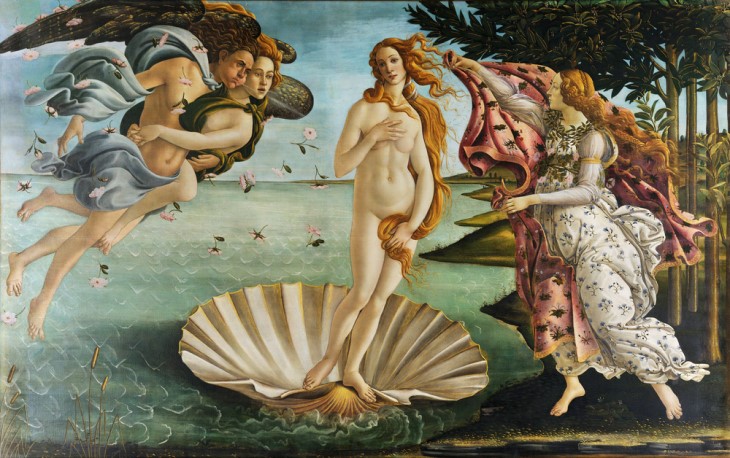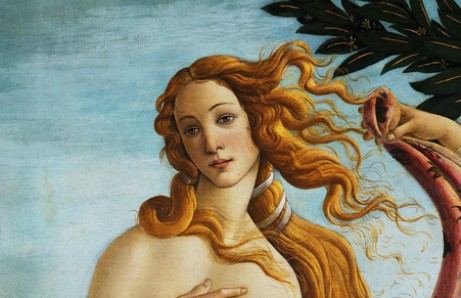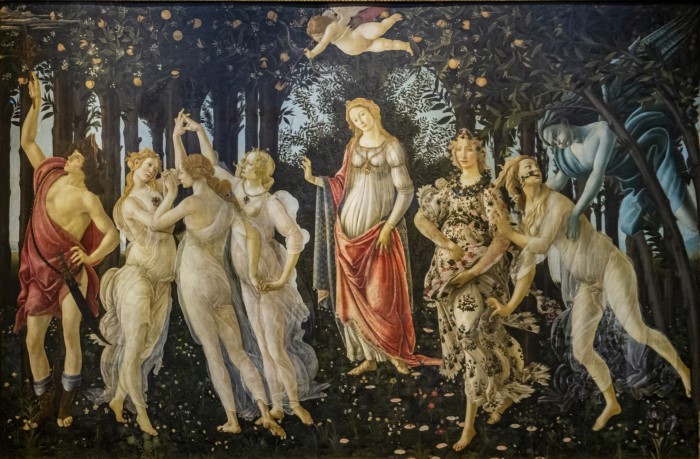
The iconic painting of the Birth of Venus by Botticelli, which is now housed in Florence's museum, was a tribute to the classical era. This artwork showed that it was possible to be religious and cultured at the same time, though the church initially opposed this idea. Nevertheless, over time, the power of the church gradually decreased and the popes eventually accepted the concept. By the 16th century, art was even welcomed into the papal court in Rome.
The Medici family, who were extremely affluent during that time, requested this masterpiece to be featured in their homes. It portrays Venus standing in the middle with two figures symbolizing the wind to her side, blowing onto her with their mouths. These breezes dry her body and move her toward the land, where a nymph is waiting with a vivid floral towel to envelop and absorb the moisture. There are trees, water, the sky, and flowers in the atmosphere, making the work vibrant and appealing to the eye.

The rippling of the water in a cyclical pattern creates a tranquil atmosphere. The people and their garments appear full of life, offering an array of colors, graciousness, and beauty. The woman on the right is draped in fabric, and her ensemble is decorated with nature-inspired trinkets, like leaves and blankets. The figures on the left also take from the environment - the nose, the mouth, the wing, and the flower. Venus is dainty and delicate, and her locks dance in the wind like tongues of fire. She attempts to conceal her intimate areas. There are, however, elements of Gothic sculpture, such as the S-position of Venus, that recall the Middle Ages.
This is a tenet of Christian belief, one that comes from the birth of Jesus. Venus connotes Botticelli's opinion of beauty. By studying the sculpture of Aphrodite from the period of Greece and Rome, classical, old and Roman art, Botticelli assimilates the ideas and then endeavors to improve them. He re-discovers reality and classical art, taking it to an advanced level.
Who is the woman behind Botticelli's Venus painting?
Well, she's not imaginary. She's a real woman. Her name was Simonetta Vespucci, a beautiful Italian noblewoman, who was the epitome of beauty in the Renaissance era. She was like Marilyn Monroe or a top model of her time, and still today we can find her image on numerous consumer products and souvenirs. Truly, a mesmerizing face.
Far from being a result of the tumultuous waves caused by a vengeful Neptune, like some Roman myth, she was born in Porto Venere (literally, "port of Venus") on the Ligurian coast, in 1453. Sitting atop a precipice, the city has been home to a Gothic church since 1198, inspiring generations of poets such as Dante, Mary Shelley, and Lord Byron.

Simonetta's family was an Italian noble family and when she was 16, she was betrothed to Marco Vespucci, a nobleman. Her relatives thought it was a great match since his family was linked to the Medici. The wedding was held at the Villa Medici at Careggi, a UNESCO World Heritage Site owned by the Medici, with a whole host of distinguished northern Italians in attendance. Later, she was courted by one of the two Medici brothers, Lorzano and Giuliano, and became the lover of one of them. This led to her fame as the most beautiful woman in Italy with her golden hair and unparalleled beauty, adored by all of Florence. Every artist from the city sought her out to be the inspiration for their work and to embody sublime, coveted beauty.
In 1469, Florence was flourishing, with the Medici family ruling the city. They filled their court with the most talented painters, authors, thinkers, and intellectuals. The men of the family determined the standards for beauty in a woman, and they thought that no one existed who could match those standards until Simonetta showed up in Florence.
Simonetta Vespucci met all these qualifications. She was an inspiration for Botticelli and a colleague of Leonardo da Vinci, and her likeness appears in many of their masterpieces with her long neck resembling a swan, her regal nose, her cascading golden hair, and her curvaceous figure. She was the paramour of Giuliano Medici (Lorenzo Medici's younger brother, who held the reins of the family). Everyone showered her with presents, poets and musicians wrote and sang songs about her, and all the nobles in the city clamored for her attention. As Lorenzo de' Medici was preoccupied with state matters, his brother had the freedom to pursue her.
The enigmatic Venus also appears in Botticelli's masterpiece, "Primavera" (1477–1482), which is an incredibly detailed work of art composed of more than 200 identifiable flowers and is a tribute to true love. His iconic "Birth of Venus" was commissioned by a Medici family member for private pleasure and remained hidden from the public for over fifty years. This progressive painting was revolutionary for its era, as it presented nudity without religious explanation and depicted a mythical subject.

The whole of Florence and Italy was grief-stricken on the night between April 26 and 27, 1476 when that goddess of beauty, just 22 years of age, succumbed to tuberculosis. Ten years later, Botticelli painted The Birth of Venus, and on his deathbed, he asked to be entombed at the feet of his muse at the Ognissanti church in Florence. His wish was granted in 1510, and during this period, he had given Simonetta's facial features to all the female characters he painted - sometimes more than one in the same artwork. It was said to be a passionate affection, and the artist, known to be gay, detested the idea of marriage. Her husband, on the other hand, remarried shortly after her death. Giuliano de Medici was killed in a conspiracy two years after Simonetta's death, in 1478, on the exact day.
An interesting little tidbit of information is that Simona's partner was related to the explorer Amerigo Vespucci, who showed Columbus that he hadn't landed in Asia, but had found America.